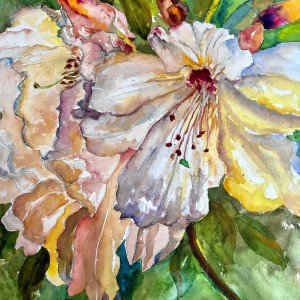The National Gallery of Australia will embark on the largest investment in its grounds in more than four decades, with the museum announcing the winning tender to recreate its sculpture gardens on Thursday.
The National Sculpture Garden, designed in the early 1980s, will need to attract about $60m in philanthropy and fundraising to realise the design of the winning multi-disciplinary team CO-AP Holdings, comprising Sydney architecture company CO-AP and landscape and urban designers Studio JEF, TARN Studio and Plus Minus Design.
The design includes seven interconnected gardens weaving around the National Gallery in a continuous circuit on the shores of Lake Burley Griffin, which will double the ground’s total space for showcasing art, culture and nature.
The sculpture garden’s existing marquee will be replaced with a permanent stainless steel and glass pavilion that will provide additional exhibition space, a new promenade and a multi-use campus square in the NGA forecourt.
Will Fung, a Sydney-based architectect and leader of the winning team, said the four companies combined forces out of a shared love for the sculpture garden’s original design by landscape architects Harry Howard, Barbara Buchanan and Roger Vidler.
“It is the most important modernist landscape in Australia and provides a beautiful counterpoint to Colin Madigan’s magnificent gallery building,” Fung said, referring to the architect who won the Australian government’s competition to design a national museum for art in 1968. The project took 14 years and cost $82m.
The NGA’s director, Nick Mitzevich, praised CO-AP Holdings for its “thoughtful approach” that showed a sensitivity and respect for the garden’s history and heritage that will reconnect the museum to its surrounding landscape.
“The jury were struck by the devotion and care CO-AP Holdings had for the National Sculpture Garden,” he said.
“CO-AP Holdings understood the significance and gravitas of the existing garden and its legacy, but also the importance of bringing the garden into the 21st century.”
The judges’ panel, led by Philip Goad, an architect and chair of the Heritage Council of Victoria, was unanimous in its decision.
Next week the NGA will unveil perhaps its most controversial acquisition since Jackson Pollock’s Blue Poles in 1973. Lindy’s Lee’s 13-tonne sculpture Ouroboros, with an unprecedented price tag of $14m, was commissioned by the NGA four years ago.
Made from scrap metal, it has taken about 200 people more than 60,000 hours to complete. The name of the work, derived from ancient Greek, refers to a serpent or dragon swallowing its own tail as a symbol of eternal renewal.





